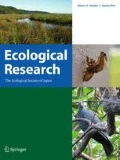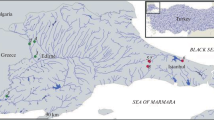Abstract
Feeding ecology of a species is the result of its evolutionary history, biology, physiology and local constraints, such as prey availability, intra- and inter-specific interactions and environmental characteristics. In this study we investigated the still unknown diet of the Sicilian pond turtle, with special emphasis to the relationships with recently introduced alien species in the “Lake Preola and Gorghi Tondi” Nature Reserve (Sicily, Italy). A total of 83 faecal samples were collected in three different periods. Emys trinacris seems an opportunistic and generalist species. The main prey taxa were aquatic invertebrates, including the invasive Procambarus clarkii, while non-aquatic preys are found sporadically. Plant matter, mainly leaves and roots of aquatic forms, was also found in high frequency with a high occurrence of fruits and seeds in spring. We did not find a significant difference in diet composition within sex and age, while an evident divergence was found between periods and sites. In particular, we noticed a decrease in prey abundance and in food-niche breadth from pre-reproductive period to post-reproductive period. Moreover a very clear difference was found between a site with allochthonous fishes and a site fish-free, with a more abundant and wide diet spectrum in the last one, as a result of the increased availability of prey. We highlighted the importance to take any possible actions to avoid the spread of fishes in other basins and to study the indirect impact of Procambarus clarkii, as possible vector of harmful trace element.



Similar content being viewed by others
References
Amundsen PA, Gabler HM, Staldvik FJ (1996) A new approach to graphical analysis of feeding strategy from stomach contents data e modification of the Costello (1990) method. J Fish Biol 48:607–614. doi:10.1111/j.1095-8649.1996.tb01455.x
Andreone F, Corti C, Ficetola F, Razzetti E, Romano A, Sindaco R (2013) Liste rosse italiane. http://www.iucn.it/scheda.php?id=1350576451. Accessed 10 January 2016 (in italian)
Ayres C, Calvino-Cancela M, Cordero-Rivera A (2010) Water Lilies, Nymphaea alba, in the summer diet of Emys orbicularis in Northwestern Spain: use of emergent resources. Chelonian Conserv Bi 9:128–131. doi:10.2744/CCB-0787.1
Bellante A, Maccarone V, Buscaino G, Buffa G, Filiciotto F, Traina A, Del Core M, Mazzola S, Sprovieri M (2015) Trace element concentrations in red swamp crayfish (Procambarus clarkii) and surface sediments in Lake Preola and Gorghi Tondi natural reserve, SW Sicily. Environ Monit Assess 187:404. doi:10.1007/s10661-015-4613-4
Caputo FC, Vogt RC (2008) Stomach flushing vs faecal analysis: the example of Phrynops rufipes (Testudines: Chelidae). Copeia 2:301–305. doi:10.1643/CH-05-031
Çiçek K, Ayaz D (2011) Food composition of the European pond turtle (Emys orbicularis) in Lake Sülüklü (Western Anatolia, Turkey). J Freshwater Eco 26:571–578. doi:10.1080/02705060.2011.580536
Clarke KR (1993) Non-parametric multivariate analysis of changes in community structure. Aust J Ecol 18:117–143. doi:10.1111/j.1442-9993.1993.tb00438.x
Consoli N (1928) Gl’interventi di piccola bonifica nella lotta contro la malaria in Sicilia. In: Sanzo F and C (eds) Rivista Sanitaria Siciliana 18. Industria Tipografica Editrice, Palermo (in italian)
Core Team R (2013) R: A language and environment for statistical computing. R Foundation for Statistical Computing, Vienna
Cusimano G, Hauser S, Vassallo M (2006) Hydrogeochemistry of a wetland area of southwestern Sicily (Italy). E-Water. http://www.ewaonline.eu/tl_files/_media/content/documents_pdf/ Publications/E- WAter/documents/43_2006_04.pdf. Accessed 10 January 2016
D’Angelo S, Lo Valvo M (2003) On the presence of the red swamp crayfish Procambarus clarkii in Sicily. Naturalista siciliano 27:325–327
Demuth JP, Buhlmann KA (1997) Diet of the terrapin Deirochelys reticularia on the Savannah River Site, South Carolina. J Herpetol 31:440–453. doi:10.2307/1565680
Di Cerbo AR (2010) Emys trinacris. In: Corti C, Capula M, Luiselli L, Razzetti E, Sindaco R (eds) Fauna d’Italia Reptilia. Calderini, Bologna, pp 163–168 (in italian)
Ernst CH, Barbour RW (1989) Turtles of the world. Smithsonian Institution Press, Washington DC
Ficetola GF, De Bernardi F (2006) Is the European “pond” turtle Emys orbicularis strictly aquatic and carnivorous? Amphibia-Reptilia 27:445–447
Fritz U, Fattizzo T, Guicking D, Tripepi S, Pennisi MG, Lenk P, Joger U, Wink M (2005) A new cryptic species of pond turtle from southern Italy, the hottest spot in the range of the genus Emys. Zool Scr 34:351–371. doi:10.1111/j.1463-6409.2005.00188.x
Fritz U, D’Angelo S, Pennisi MG, Lo Valvo M (2006) Variation of Sicilian pond turtles, Emys trinacris - What makes a species cryptic? Amphibia-Reptilia 27:513–529. doi:10.1163/156853806778877095
Geiger WP, Alcorlo P, Baltanas A, Montes C (2005) Impact of an introduced crustacean on the trophic webs of Mediterranean wetlands. Biol Invasions 7:49–73. doi:10.1007/1-4020-3870-4_6
Genovesi P (2007) Towards a European strategy to halt biological invasions in inland waters. In: Gherardi F (ed) Biological invaders in inland waters: profiles, distribution, and threats, Invading nature. Springer series in Invasion ecology 2, pp 627–638
Gherardi F (2011) Crayfish. In: Simberloff D, Rejmánek M (eds) Encyclopedia of Biological Invasions. University of California Press, Berkeley, pp 609–612
Gherardi F, Mavuti KM, Pacini N, Tricarico E, Harper DM (2011) The smell of danger: chemical recognition of fish predators by the invasive crayfish Procambarus clarkii. Freshwater Biol 56:1567–1578. doi:10.1111/j.1365-2427.2011.02595.x
Harper DAT, Ryan PD (2001) PAST: Palaeontological statistics software package for education and data analysis. Palaeontol Electron 4:1–9
Hart DR (1983) Dietary and habitat shifts of red-eared turtles (Pseudemys scripta) in a southern Louisiana population. Herpetologica 39:285–290
Hurlbert SH (1984) Pseudoreplication and the design of ecological field experiments. Ecol Monogr 54:187–211. doi:10.2307/1942661
Ivlev VS (1961) Experimental ecology of the feeding of fishes. Yale University Press, New Haven
Kennett R, Tory O (1996) Diet of two freshwater turtles, Chelodina rugosa and Elseya dentata (Testudines: Chelidae) from the wet–dry tropics of northern Australia. Copeia 1996:409–419. doi:10.2307/1446857
Kotenko TI (2000) The European pond terrapin (Emys orbicularis) in the steppe zone of Ukraine. Stapfia 69:87–106
Lindeman PV (1996) Comparative life history of painted terrapins (Chrysemys picta) in two habitats in the inland Pacific Northwest. Copeia 1996:114–130. doi:10.2307/1446947
Lopez-Archilla AI, Molla S, Coleto MC, Guerrero MC, Montes C (2004) Ecosystem metabolism in a Mediterranean shallow lake (Laguna Sta Olalla, Donana National Park, SW Spain). Wetlands 24:848–858. doi:10.1672/0277-5212(2004)024[0848:EMIAMS]2.0.CO;2
Lowe S, Browne M, Boudjelas S, De Poorter M (2000) 100 of the World’s Worst Invasive Alien Species A selection from the Global Invasive Species Database. Published by The Invasive Species Specialist Group (ISSG) a specialist group of the Species Survival Commission (SSC) of the World Conservation Union (IUCN), updated and reprinted version: November 2004
Luiselli L, Akani GC, Politano E, Odegbune E, Bello O (2004) Dietary shifts of sympatric freshwater turtles in pristine and oil-polluted habitats of the Niger Delta, southern Nigeria. Herpetol J 14:57–64
MacArthur RH, Pianka ER (1966) On the optimal use of a patchy environment. Am Nat 100:603–609. doi:10.1086/282454
Marrone F, Sacco F, Arizza V, Arculeo M (2016) Amendment of the type locality of the endemic Sicilian pond turtle Emys trinacris Fritz et al. 2005, with some notes on the highest altitude reached by the species (Testudines, Emydidae). Acta Herpetol 11:59–61. doi:10.13128/Acta_Herpetol-17873
Miracle MR, Moss B, Vicente E, Romo S, Rueda J, Bécares E, Fernández-Aláez C, Fernández-Aláez M, Hietala J, Kairesalo T, Vakkilainen K, Stephen D, Hansson LA, Gyllström M (2006) Response of macroinvertebrates to experimental nutrient and fish additions in European localities at different latitudes. Limnetica 25:585–612
Miyake M, Miyashita T (2011) Identification of alien predators that should not be removed for controlling invasive crayfish threatening endangered odonates. Aquat Conser 21:292–298. doi:10.1002/aqc.1178
Mooney HA, Cleland EE (2001) The evolutionary impact of invasive species. PNAS 98:5446–5461. doi:10.1073/pnas.091093398
Oltra R, Miracle M (2000) Spatio-temporal diversity of the crustacean populations, polichaete larvae and protozoans in the Estany de Cullera meromictic lagoon (Valencia). Limnetica 19:53–65
Ottonello D, Salvidio S, Rosecchi E (2005) Feeding habits of the European pond terrapin Emys orbicularis in Camargue (Rhône delta, Southern France). Amphibia-Reptilia 26:562–565. doi:10.1163/156853805774806241
Poulin B, Lefebvre G, Crivelli AJ (2007) The invasive red swamp crayfish as a predictor of Eurasian bittern density in the Camargue, France. J Zool 273:98–105. doi:10.1111/j.1469-7998.2007.00304.x
Rodríguez CF, Becares E, Fernandez-Alaez M (2003) Shift from clear to turbid phase in Lake Chozas (NW Spain) due to the introduction of American red swamp crayfish (Procambarus clarkii). Hydrobiologia 506–509:421–426. doi:10.1023/B:HYDR.0000008626.07042.87
Rodríguez-Pérez H, Hilaire S, Mesléard F (2015) Temporary pond ecosystem functioning shifts mediated by the exotic red swamp crayfish (Procambarus clarkii): a mesocosm study. Hydrobiologia. doi:10.1007/s10750-015-2523-7
Román J (2014) Artificial water points for wildlife management facilitate the spread of red swamp crayfish (Procambarus clarkii). Manag Biol Invasion 5:341–348. doi:10.3391/mbi.2014.5.4.04
Servan J, Baron J, Bels R, Bour V, Lancon M, Renon G (1986) Le marquage des tortues d’eau douce: application a la cistude d’Europe Emys orbicularis (Reptilia, Chelonii). Bull Soc Herp Fr 37:9–17 (in french)
Shannon CE, Weaver W (1948) A mathematical theory of communication. Bell Syst Tech J 27: 379–423 and 623–656
Shea K, Chesson P (2002) Community ecology theory as a framework for biological invasions. Trends Ecol Evol 17:170–176. doi:10.1016/S0169-5347(02)02495-3
Souza FL, Abe AS (2000) Feeding ecology, density and biomass of the freshwater turtle, Phrynops geoffranus, inhabiting an urban river in south-eastern Brazil. J Zool 252:437–446. doi:10.1111/j.1469-7998.2000.tb01226.x
Stephens PR, Wiens JJ (2003) Ecological diversification and phylogeny of emydid turtles. Biol J Linn Society 79:577–610. doi:10.1046/j.1095-8312.2003.00211.x
Szoboszlai AI, Thayer JA, Wood SA, Sydeman WJ, Koehn LE (2015) Forage species in predator diets: synthesis of data from the California Current. Ecol Inf 29:45–56. doi:10.1016/j.ecoinf.2015.07.003
Tablando Z, Tella JL, Sánchez-Zapata JA, Hiraldo F (2010) The paradox of the long-term positive effects of a north american crayfish on a european community of predators. Conserv Biol 24:1230–1238. doi:10.1111/j.1523-1739.2010.01483.x
van Dijk PP (2009) Emys trinacris. The IUCN Red List of Threatened Species 2009: e.T158469A5199795. Accessed 10 January 2016
Vilizzi L, Tarkan AS, Copp GH (2015) Experimental evidence from causal criteria analysis for the effects of common carp Cyprinus carpio on freshwater ecosystems: a global perspective. Rev Fish Sci 23:253–290. doi:10.1080/23308249.2015.1051214
Vogt R (1981) Food partitioning in three sympatric species of Map Turtle, Genus Graptemys Testudinata, Emydidae). Am Midl Nat 105(1):102–111. doi:10.2307/2425015
Zuffi MAL (2000) Conservation biology of the European pond turtle Emys orbicularis (L) in Italy. Stapfia 69:219–228
Zuffi MAL, Gariboldi A (1995) Sexual dimorphism in Italian populations of the European pond terrapin, Emys orbicularis. In: Llorente GA, Montori A, Santos X, Carretero MA (eds) Scientia herpetologica. Asociacion Herpetologica Espanola, Barcelona, pp 124–129
Acknowledgements
We are grateful to Nino Castelli, Michela Giribaldo, Maurizio Marchese, Nicola Napolitano, Gianpiero Pace for their help during field surveys and with Alice Gastaldi, Silvia Losorgio, Sebastiano Salvidio for their help during laboratory work. Capture and handlings permits were released by the Ministero dell’Ambiente e della Tutela del Territorio e del Mare (DPN/2012/0003156 on 9.X.2012). D.O. was supported by Societas Europaea Herpetologica grant in Herpetology 2014.
Author information
Authors and Affiliations
Corresponding author
Ethics declarations
Funding
This study was partially funded by Societas Europaea Herpetologica grant in Herpetology 2014.
Conflict of interest
The authors declare that they have no conflict of interest.
About this article
Cite this article
Ottonello, D., D’Angelo, S., Oneto, F. et al. Feeding ecology of the Sicilian pond turtle Emys trinacris (Testudines, Emydidae) influenced by seasons and invasive aliens species. Ecol Res 32, 71–80 (2017). https://doi.org/10.1007/s11284-016-1416-1
Received:
Accepted:
Published:
Issue Date:
DOI: https://doi.org/10.1007/s11284-016-1416-1




